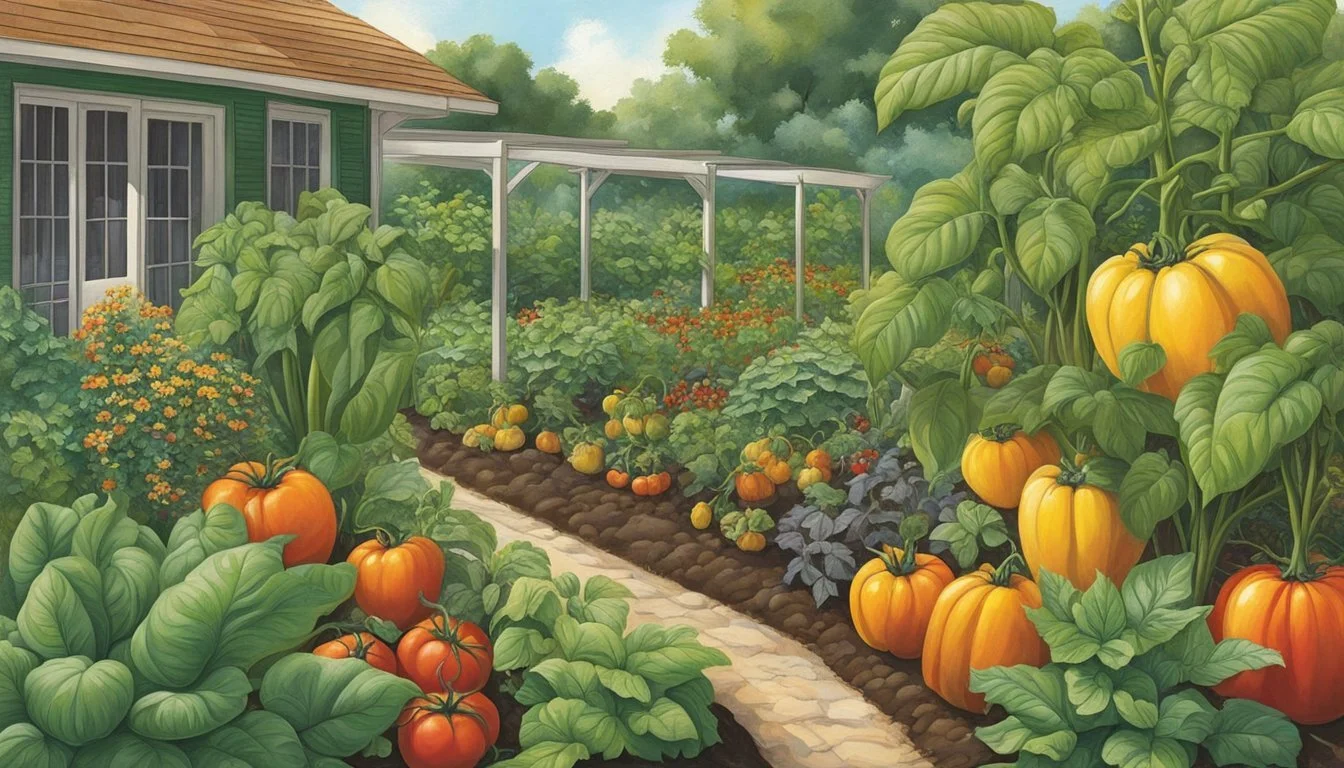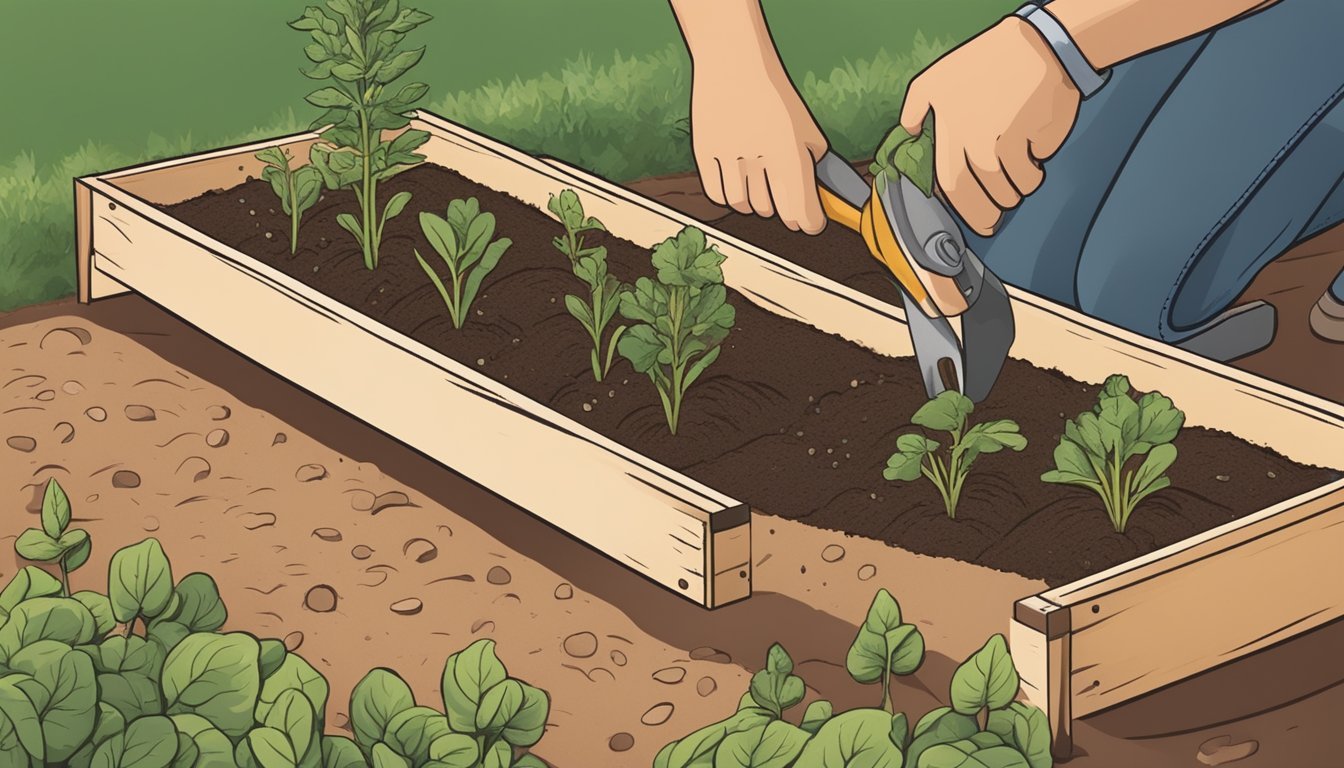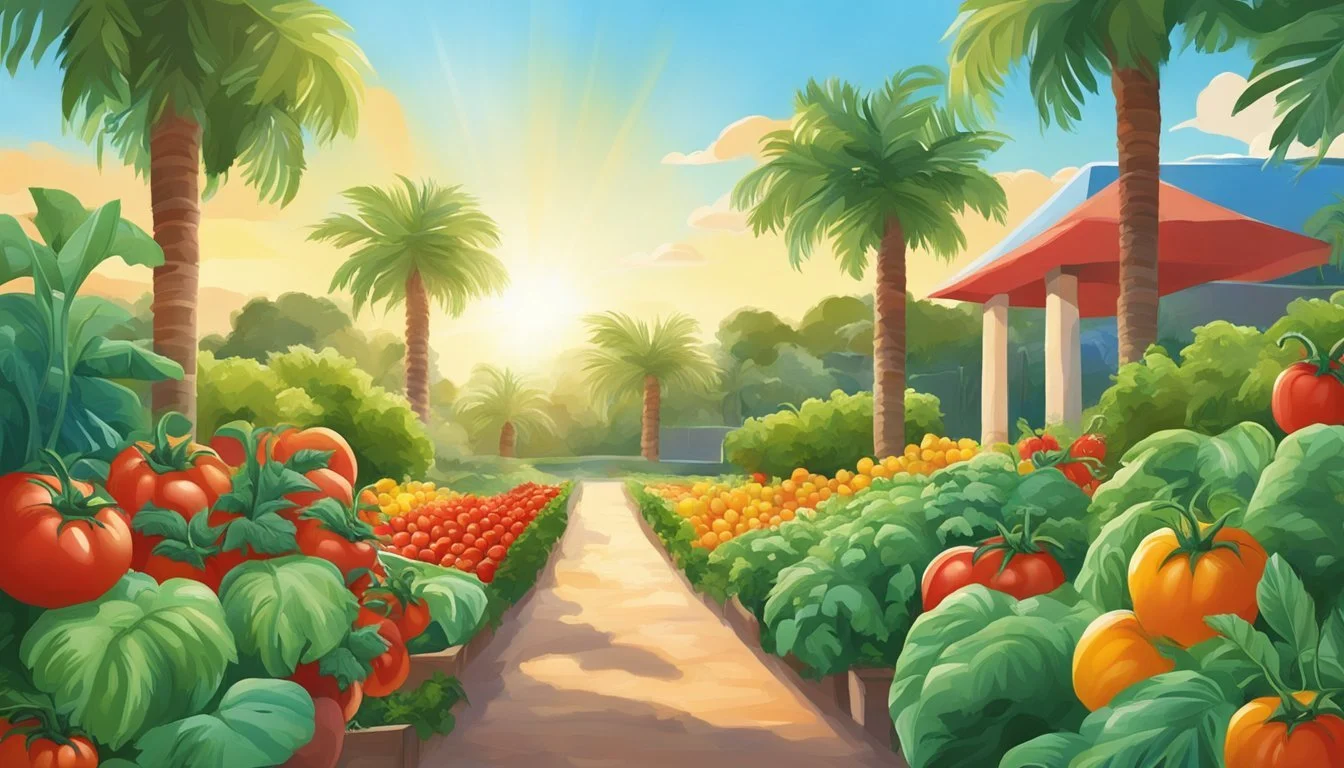Vegetable Gardening in Florida
Essential Tips for a Thriving Garden
This Article is Part of Our Guide on Vegetable Gardening by State
Vegetable gardening in Florida presents a unique set of advantages and challenges due to the state's diverse climate. With over 900 miles stretching from North to South, Florida offers gardeners a variety of regional conditions, making it possible to grow a wide range of vegetables throughout the year. The warm climate, characterized by hot summers and mild winters, allows for continuous cultivation, while attention must be given to selecting crops that can thrive in the subtropical temperature and humidity.
Gardeners in Florida must take into account the state's varying climatic zones, which range from temperate in the north to tropical in the south. This means understanding local frost dates and planting times to ensure a successful harvest. Southern areas, being largely frost-free, can support a different collection of vegetables when compared to the occasionally freezing northern regions. Additionally, soil type, rainfall patterns, and seasonal pests must be considered to tailor gardening practices to local conditions.
Water management is another critical aspect of vegetable gardening in Florida, as the state experiences both periods of heavy rainfall and times of drought. High humidity can increase the likelihood of plant disease, making it essential for gardeners to implement strategies for proper irrigation and disease prevention. By choosing the right vegetables for their specific region and adhering to best practices for planting and maintenance, Floridians can turn their gardens into plentiful sources of fresh produce all year round.
Understanding Florida's Unique Climate
Florida's climate is often described by its distinct regional variations, highlighting the state's vast agricultural diversity. The weather in Florida is generally categorized by hot summers and mild winters, with a gradient of variability as one travels from the northern part of the state to the south.
North Florida experiences distinct seasons including occasional frosts during winter. In contrast, Central Florida has a more consistent pattern of warmth year-round but is not immune to cold snaps. South Florida maintains a tropical climate, with minimal fluctuation in temperatures across seasons, rarely ever seeing frost.
Sunshine and Rainfall Distribution:
Sun: Florida is well-known for its abundant sunshine, crucial for successful vegetable gardening.
Moisture: The state experiences high humidity and significant rainfall, especially during the summer months.
Climate Zones:
North Florida: USDA Zones 8a to 9a
Central Florida: USDA Zones 9b to 10a
South Florida: USDA Zones 10b to 11a
These zones are essential for gardeners as they dictate the types of vegetables suitable for planting in each region.
The state's unique climate poses both opportunities and challenges for gardeners. The long growing season is a clear advantage, yet persistent moisture can also increase the likelihood of plant diseases. Understanding Florida's climatic conditions is vital for any gardening endeavor, ensuring the selection of the right plants and the implementation of proper care techniques to thrive within each part of the state.
Planning Your Vegetable Garden
A successful vegetable garden in Florida starts with thorough planning. This includes selecting suitable vegetables, determining optimal planting dates, and designing an effective garden layout.
Selecting the Right Vegetables
Florida gardeners have a wide variety of vegetables to choose from, but it's essential to pick those best suited to the state's climate. Vegetables such as tomatoes, peppers, cucumbers, and beans thrive in Florida's warm conditions. Gardeners should also consider regional variations; southern areas can support tropical vegetables, while northern regions may be more suitable for traditional crops.
Determining Planting Dates
The timing of planting is crucial to the success of a vegetable garden in Florida. Table 1 illustrates typical planting dates:
Vegetable Spring Planting Dates Fall Planting Dates Tomatoes Feb - Apr Aug - Sep Cucumbers Feb - Apr Aug - Sep Peppers Feb - Apr Aug - Sep
These dates may vary based on specific regional climates. Gardeners can check local resources like county Extension offices or the Florida Vegetable Gardening Guide for more precise information.
Designing Your Garden Layout
When designing a garden layout, it's important to maximize sunlight exposure and ensure easy access for maintenance. Tall plants such as corn should be placed on the north side of the garden to prevent shading smaller plants. Medium-height plants can be situated in the center, with shorter plants like lettuce or strawberries toward the south side. Ample space between rows is crucial for access and facilitates proper air circulation.
Soil Preparation and Management
Proper soil preparation is a critical step for successful vegetable gardening in Florida. It involves conducting soil tests, improving soil quality with organic matter, and utilizing mulching and composting techniques to maintain soil health.
Conducting a Soil Test
Before planting, a gardener should test the soil to determine its pH level and nutrient composition. Soil testing kits are available, or a sample can be sent to a local extension service. In Florida, ideal soil pH levels generally range from 5.5 to 7.0, although South Florida soils can have pH levels up to 8.5.
Steps for Soil Testing:
Collect a soil sample from several locations in the garden.
Mix the samples together in a clean container.
Dry the soil sample at room temperature.
Submit the mixed sample to a testing lab or use a home testing kit.
Improving Soil Quality
Upon receiving soil test results, one can amend the soil accordingly. Florida's sandy soil benefits from the addition of organic matter, such as compost or decomposed mulch, to improve nutrient content and water retention. Incorporating organic matter should occur at least three weeks before planting. If drainage is poor, consider constructing a raised bed to promote better root health.
Amendments for Soil Improvement:
Organic compost: to increase nutrient levels.
Finely ground mulch: to enhance soil structure and moisture.
Mulching and Composting
Mulching helps retain soil moisture, regulate temperature, and inhibit weed growth. Organic mulches, such as straw or bark, can be applied around plants. Composting involves the decomposition of organic materials, providing a steady supply of nutrients to the garden when used as mulch or incorporated into the soil.
Benefits of Mulching and Composting:
Moisture retention: Reduces the frequency of watering.
Nutrient supply: Breakdown of compost adds essential nutrients back to the soil.
For mulching:
Apply a 2-3 inch layer of organic mulch around the base of plants.
For composting:
Choose a composting method (bin, pile, tumbler)
Regularly turn the compost to ensure even decomposition.
By adhering to these soil preparation and management practices, one can create an optimal growing environment for vegetable gardening in Florida.
Planting Techniques
In Florida's unique climate, knowing when and how to plant can make all the difference in a vegetable garden. Choosing between starting with seeds or transplants, understanding the specific sunlight and water requirements, and protecting plants from temperature extremes are crucial steps to success.
Starting with Seeds or Transplants
When planting vegetables in Florida, gardeners have the option to start with either seeds or transplants. Seeds are generally more cost-effective and offer a broader variety of plant choices, but they require more time and care to reach maturity. For a successful seed start, late winter or early spring—from February to April—is the best time. On the other hand, transplants can offer a head start and may be more suitable for the busy gardener or those looking for more immediate results. For cooler season crops, starting in September or early fall can yield a productive harvest.
Understanding Sunlight and Water Requirements
Proper understanding of sunlight and water needs is essential to plant health and productivity. In Florida, the high intensity of direct sunlight can be challenging, so it's important to ensure plants receive adequate but not excessive exposure. Ideal sunlight conditions for most vegetables range from 6 to 8 hours per day. When it comes to watering, establishing a consistent irrigation schedule helps prevent stress on plants. The state's summer heat and humidity necessitate regular watering to maintain even soil moisture, but overwatering can be as detrimental as under-watering.
Protecting Plants from Temperature Extremes
Florida's weather can be unpredictable, with occasional frosts in the winter months and intense heat in the summer. Protecting plants from these extremes is crucial. During unexpected freeze events, especially in January, delicate plants should be covered overnight with frost cloths or blankets to prevent damage. Conversely, during the peak summer heat, providing shade during the hottest parts of the day keeps plants from wilting and suffering from heat stress. In both scenarios, mulching helps regulate soil temperature and retain moisture.
Maintaining a Healthy Garden
Creating a healthy vegetable garden in Florida involves careful attention to irrigation practices, appropriate fertilization, and effective weed and pest management. These practices not only help to maintain plant health and proper growth but also contribute to the sustainability and productivity of the garden space.
Irrigation and Water Conservation
Adequate water supply is crucial for vegetable growth, yet conserving water remains a key concern in Florida's climate. Gardeners should implement drip or soaker hose systems to deliver water directly to the plant's roots, reducing evaporation and conserving water. These methods are efficient and help in maintaining the balance between the plant's needs and water usage. Additionally, mulching helps retain soil moisture and keeps roots cool.
Fertilizing for Optimal Growth
Healthy growth often requires additional nutrients, which can be provided through the use of fertilizers. Organic options are recommended to improve soil health and reduce environmental impact. On a schedule, gardeners should add compost or a balanced organic fertilizer to provide essential nutrients like nitrogen, phosphorus, and potassium, aiming for optimal plant development and yield.
Weed and Pest Management
Weeds compete for resources, while pests can significantly damage crops. Regularly inspecting and hand-pulling weeds is an organic method to keep gardens clean. For pests like aphids, insects, and armyworm, integrated pest management strategies should be employed. Introducing beneficial insects and pollinators to the garden can naturally reduce pest populations. Additionally, Florida gardeners are advised to use natural pest control methods when possible to minimize harmful chemicals and protect the environment.
Harvesting and Enjoying Your Produce
Proper harvesting times and methods can significantly impact the taste and longevity of vegetables. Dealing effectively with diseases and pests is crucial to ensure a quality yield.
Timing Your Harvest
The gardener should harvest vegetables when they are at their peak of ripeness to maximize flavor and nutritional value. For example, tomatoes should be plucked when they are uniformly colored and slightly firm, whereas leafy greens like lettuce are often best when the leaves are tender and fully formed. Use the following guidelines:
Tomatoes: Harvest when fully colored and slightly firm
Lettuce: Pick when leaves are tender and full
Carrots: Pull when they reach the desired size, often when they are half an inch in diameter
Handling Diseases and Pests Aftermath
Post-harvest, inspect the fresh vegetables closely for signs of diseases and pests. Any diseased or infested produce should be removed immediately to prevent further contamination. If a vegetable is affected, it does not necessarily mean it is a total loss. Sometimes, simply removing the affected area can salvage part of the produce. Sanitation is key; tools and hands should be washed thoroughly after handling diseased plants to prevent the spread of pathogens.
Extending the Gardening Season
In Florida, gardeners have the unique advantage of a prolonged growing season. This section explores how the use of cover crops and careful planning can facilitate a year-round harvest.
Using Cover Crops and Crop Rotation
Cover crops play a vital role in maintaining soil health and fertility through the Florida gardening calendar, and they are integral to extending the gardening season. They protect against soil erosion, suppress weeds, and improve soil structure. During the summer, options such as cowpea, velvet bean, soybean, and sunflower refresh the soil by adding organic matter. In winter, cereal rye, crimson clover, and Austrian winter pea can be planted. Crop rotation is equally important, as it prevents soil depletion and reduces pest and disease problems.
Summer Cover Crops:
Cowpea
Velvet bean
Soybean
Sunflower
Winter Cover Crops:
Cereal rye
Crimson clover
Austrian winter pea
Rotating between these crops and vegetable crops can help gardeners utilize their land throughout the entire year, avoiding fallow periods and maximizing production.
Planning for Year-Round Harvest
A strategic approach to planning can yield a bounty of vegetables throughout the year. Gardeners should select vegetable varieties that are suitable for Florida's climate and stagger planting times to ensure a continuous supply.
Early Spring Planting: Select frost-tolerant vegetables that can be planted in the cooler months.
Summer Planting: Choose heat-tolerant varieties that can withstand Florida's intense summer heat.
Fall Planting: Plant crops that will mature in the cooler temperatures of late fall and early winter.
By integrating knowledge of Florida's growing seasons with appropriate vegetable selection, gardeners can sustain a productive garden year-round. They must remain vigilant about changes in weather patterns and adjust their planting schedules accordingly.
Resources and Further Learning
When undertaking vegetable gardening in Florida, gardeners have a wealth of resources and opportunities for further learning to navigate the unique growing conditions they will encounter. Two key resources are local gardening communities and the University of Florida IFAS Extension, each offering tailored support for the diverse climates of central, north, and south Florida.
Local Gardening Communities
Local gardening communities provide a platform for Florida gardeners to share experiences, tips, and support. These groups often accommodate gardeners from all skill levels and are valuable for those just starting out. Interested individuals can connect with various gardening clubs and online forums dedicated to Florida vegetable gardening, where the collective wisdom can help guide their garden planning and maintenance.
County-Based Groups: Many counties offer local chapters where gardeners can meet to discuss gardening challenges and successes specific to their regional climate.
Seasonal Workshops: It is common for these communities to organize workshops focusing on seasonal vegetables and best practices for dealing with Florida's hot summers and occasional freezes.
University of Florida IFAS Extension
The University of Florida IFAS Extension is a critical resource, providing scientifically backed information and guidance to ensure successful vegetable gardening endeavors.
Publications and Guides: The Extension offers a range of publications on topics such as organic gardening, pest management, and soil preparation, which are especially useful for new and veteran gardeners alike.
Workshops and Master Classes: At the county level, the Extension conducts workshops and master classes that cover aspects of Florida vegetable gardening, including integrated pest management and proper watering techniques.
Regional Support:
Central Florida: The Extension offers advice tailored to the mild winters and long growing seasons characteristic of the central region.
North Florida: Gardeners receive guidance on how to manage their gardens during cooler temperatures and instructions for selecting cold-hardy vegetable varieties.
South Florida: Emphasis is placed on tropical vegetable varieties and managing humidity and pests that are prevalent in this region.
Conclusion
Vegetable gardening in Florida offers a dynamic environment due to its distinct climate and soil conditions. Gardeners in the state benefit from a long growing season, allowing a wide variety of vegetables to thrive. However, success hinges on understanding the regional variations, from the frost-free southern areas to the colder northern regions.
Garden Care in Florida:
Soil Preparation: Rich, well-drained soil is fundamental; adding organic matter can enhance fertility.
Watering: Consistency is key, complementing Florida's rainfall patterns. Drip irrigation or soakers can prevent disease by minimizing leaf wetness.
Temperature Management: Northern Florida may require frost protection strategies, while southern areas need shade to protect from intense heat.
Pest Control: Integrated pest management practices promote a healthy garden ecosystem.
Florida's Regional Climates Affect Gardening:
North Florida: Experiences regular freezes; gardeners must be wary of frost dates.
Central Florida: Mild winters allow a broad range of vegetables but prepare for occasional freezes.
South Florida: Rare frosts make it ideal for tropical vegetables year-round.
Gardeners must adapt their practices to these conditions to ensure the health and productivity of their vegetable gardens. Proper care tailored to Florida's unique setting fosters a bountiful harvest. The area's high humidity and occasional extreme weather require vigilance and resilience from the gardener. With the right approach, vegetable gardening in Florida can be deeply gratifying and fruitful.







